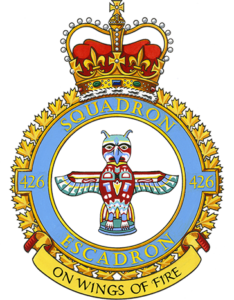 No. 426 Squadron
No. 426 Squadron
Badge A thunderbird
Motto On wings of fire
Authority King George VI, October 1943
The thunderbird is a mythical bird, the sight of which is supposed to cause havoc and death to those who perceive it. It was the name given by some Indians to the first aeroplane they saw. The thunderbird signified disaster to those on the ground who have incurred its displeasure.
Formed at Dishforth, Yorkshire, England on 15 October 1942 as the RCAF’s 24th – seventh Bomber – squadron formed overseas, the unit flew Wellington, Lancaster and Halifax aircraft on strategic and tactical bombing operations. After hostilities in Europe, to meet a need for longrange transport units to support the proposed “Tiger” Force for duty in the Pacific, it was redesignated Transport on 25 May 1945 and converted to Liberator aircraft. Between October and December 1945, it airlifted British troops to Egypt and Indian troops from Egypt to India, and British troops back to England. The squadron was disbanded at Tempsford, Bedfordshire on 1 January 1946. (1)
Brief Chronology: Formed as No. 426 (B) Sqn, Dishforth, Yorks., Eng. 15 Oct 42. Redesignated No. 426 (T) Sqn, Driffield, Yorks. 25 May 45. Disbanded at Tempsford, Beds. 1 Jan 46.
Title or Nickname: ‘Thunderbird”
Adoption: City of Regina Auxiliary, Sask.
Commanders
W/C S.S. Blanchard 15 Oct 42 – 14 Feb 43 KIA.
W/C L. Crooks (RAF), DSO, DFC 15 Feb 43 – 17 Aug 43 KIA.
W/C W.H. Swetman, DSO, DFC 18 Aug 43 – 4 Apr 44 OTE.
W/C E.C. Hamber, DFC 8 Apr 44 – 10 Jul 44 OTE.
W/C C.W. Burgess 11 Jul 44 – 2 Jan 45 OTE.
W/C F.C. Carling-Kelly 3 Jan 45 – 28 Jan 45 POW.
W/C C.M. Black, DFC 29 Jan 45 – 24 May 45.
W/C D.R. Miller, AFC 25 May 45 – 11 Dec 45.
W/C J.F. Green, DFC 12 Dec 45 – 1 Jan 46.
Higher Formations and Squadron Locations
Bomber Command:
No. 4 Group,
- Dishforth, Yorks. 15 Oct 42 – 31 Dec 42.
No. 6 (RCAF) Group,
No. 61 (RCAF) Base,
- Dishforth, Yorks. 1 Jan 43 – 17 Jun 43.
No. 62 (RCAF) Base,
- Linton-on-Ouse, Yorks. 18 Jun 43 – 24 May 45.
Transport Command:
No. 47 Group,
- Driffield, Yorks. 25 May 45 – 24 Jun 45.
- Tempsford, Beds. 25 Jun 45 – 1 Jan 46.
Representative Aircraft (Unit Code OW)
Vickers Wellington Mk.III (Oct 42 – Apr 43)
- X1599 E
Vickers Wellington B.Mk.X (Mar – Jun 43)
Avro Lancaster B.Mk.II (Jul 43 – May 44)
- DS621 N DS647 R DS686 D DS687 L DS711 B DS741 T DS757 D DS759 K DS760 M DS763 0 DS771 P DS775 W DS789 A DS829 J DS838 J DS840 C DS841 Q DS852 P LL621 N LL634 F LL687 L LL688 R LL700 X
Handley Page Halifax B.Mk.III (Apr – Jun 44)
- LK796 M LK871 K LK879 P LK880 C LK883 E LW377 G LW382 Q LW598 J LW682 M MZ598 J MZ600 D MZ645 N MZ750 S MZ682 N MZ690 U NA510 E
Handley Page Halifax B.Mk.VII (Jun 44 – May 45)
- LW199 C LW200 N LW201 D LW203 F LW204 K LW205 Y LW206 Q LW207 W LW209 E LW210 B LW510 D LW775 G NP684 0 NP709 A NP737 Z NP770 G NP779 C NP797 G NP799 J NP800 S NP811 G NP818 M PN238 L RG452 V
- During Dec 44 – Mar 45 the squadron also had 5 B.Mk.III’s: NA202 A NA204 N NR134 Z NR144 V RG350 K
Consolidated Liberator C.Mk.VI&VIII (Jul – Dec 45, Unit Code OLW)
- KG918 X KG983 Y KH179 HW KH181 LW KH224 NW KH329 Z KH333 JW KH381 W KK255 Q KK267 0 KK340 R KK374 T KL618 K KL619 H KL621 D KL625 V KL639 F KL650 J KL663 C KL670 G KN833 OW
Operational History: First Mission 14/15 January 1943, 7 Wellington Ill’s from Dishforth bombed Lorient, France.
Last Mission: Bombing 25 April 1945, 20 Halifax VII’s from Linton-on-Ouse bombed gun positions on the Island of Wangerooge; 1 aircraft failed to return.
First Mission, Transport: 30 September 1945, 2 Liberators departed Tempsford for India each carrying 26 passengers and both returned on 7 October with 26 passengers. Aircraft and captains were: KL641 OLW-A (F/L K.W. Warner to India, F/O W.A. Craig return to England), KK341 OLW-P (F/O H.E. Miskiman to India, F/L L. Greenburgh return to England).
Last Mission: 20 December 1945, 4 Liberators departed for India; the last (KK265 OLW-O) returned to England on 29 December.
Summary Bomber Missions/Sorties: 268 (including 242 bombing, 19 sea-mining, 7 sea searches)/3233.
- Operational/Non-operational Flying Hours: 11,184/3327.
- Bombs dropped: 8997 tons.
- Victories: Aircraft: 4 destroyed, 1 probably destroyed, 5 damaged.
- Casualties:
- Operational: 88 aircraft; 557 aircrew, of whom 87 were killed, 337 presumed dead, 97 POW, 36 evaded capture, were interned or proved safe.
- Non-operational: 4 personnel killed.
Transport Sorties: 242.
- Operational/Non-operational Flying Hours: 5631/3716.
- Airlifted: 5500 passengers.
- Casualties: nil.
Honours and Awards: 2 DSO’s, 2 bars to DFC, 130 DFCs, 1 CGM, 25 DFM’s, 2 BEM’s, 1 DFC (USA), 13 MiD’s.
Battle Honours:
- English Channel and North Sea 1943.
- Baltic 1943.
- Fortress Europe 1943-1944.
- France and Germany 1944-1945: Biscay Ports 1943-1944, Ruhr 1943-1945, Berlin 1943-1944. German Ports 1943-1945, Normandy 1944, Rhine. Biscay 1943.
(1) Personnel volunteering for further service were assigned along with the squadron’s aircraft to an RAF Liberator squadron at Tempsford.








